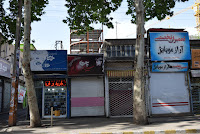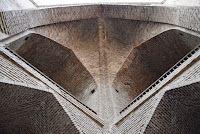(...)
We walked towards Darvâzah Sangi, the Lion stone entrance gate to the once walled city of Khoy, of which this is one of the very few remains. The sky had gone gray and it started to rain, which fortunately didn't affect us much as we were very close to the old bazar whose alleys we strolled along for a while. Most stalls, not to say all, were closed, which was a bit of a pity really, though it allowed us to get a much better perspective of the overall architectural structure which we wouldn't otherwise have been able to notice.




We were supposed to visit the Motelleb Khan Mosque, whose entrance was locked. Upon asking several people whether it would open answers were ambiguous so we strolled around the surrounding streets and alleys until we came across a young local female guide who let us know it would open later and suggested we visit the local Museum, which was not in our scheduled visits.


I was happy she finally convinced Mr. Rovillé, because we ended up visiting a rather small yet very well organized Museum, which comprised both archeological and ethnical sections, whilst we awaited the potential opening hour for the Mosque.












Abbasid King turquoise plan signboard (detail) dating from the Safvid period.




The female guide who took us there (left). The Museum guide whose additional information we thoroughly followed.

When we made it back to one of the main streets we realised that the Motelleb Mosque was open, so we finally visited it. It looked very different from any we had seen before once the prayer space was roofless and both the exterior and interior lacked any architectural decoration with the exception of the stuccoed upper part of the altar. It is believed to have been initially built in the Ilkhanid era and later reconstructed in the Kajarid period, which could partly provide the answer.


































No comments:
Post a Comment